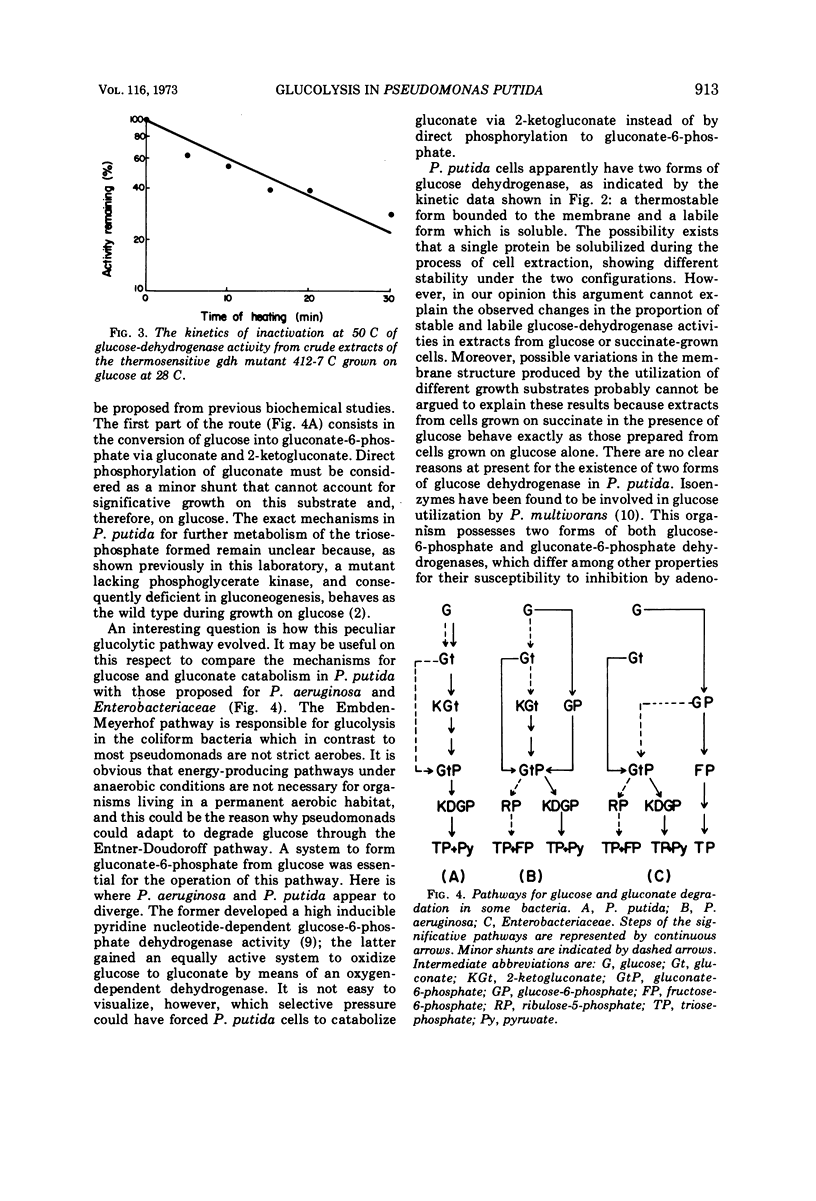Abstract
A number of mutants in which glucolysis is impaired have been isolated from Pseudomonas putida. The study of their behavior shows that this organism possesses a single glucolytic pathway with physiological significance. The first step of the pathway consists in the oxidation of glucose into gluconate. Two proteins with glucose dehydrogenase activity appear to exist in P. putida but the reasons for this duplicity are not clear. The process continues with the formation of 2-ketogluconate which is in turn converted into gluconate-6-phosphate. This is proved by the fact that mutants unable to form gluconate-6-phosphate from 2-ketogluconate show extremely slow growth on glucose or gluconate (generation times are increased more than 100 times). Other possible routes for the conversion of glucose into gluconate-6-phosphate, the glucose-6-phosphate pathway, or the direct phosphorylation of the gluconate formed by glucose oxidation are only minor shunts in P. putida. The Entner-Doudoroff enzymes, which catalyze the conversion of gluconate-6-phosphate into pyruvate and triosephosphate, appear to be essential to grow on glucose and also on gluconate and 2-ketogluconate. A significative role of the pentose route in the catabolism of these substrates is not apparent from this study. In contrast, P. putida strains showing no activity of the Entner-Doudoroff enzymes grow readily on fructose, although there is evidence that this hexose is at least partially catabolized via gluconate-6-phosphate.
Full text
PDF






Selected References
These references are in PubMed. This may not be the complete list of references from this article.
- Aparicio M. L., Ruiz-Amil M., Vicente M., Cánovas J. L. The role of phosphoglycerate kinase in the metabolism of Pseudomonas putida. FEBS Lett. 1971 May 20;14(5):326–328. doi: 10.1016/0014-5793(71)80292-2. [DOI] [PubMed] [Google Scholar]
- ENTNER N., DOUDOROFF M. Glucose and gluconic acid oxidation of Pseudomonas saccharophila. J Biol Chem. 1952 May;196(2):853–862. [PubMed] [Google Scholar]
- FRAMPTON E. W., WOOD W. A. Carbohydrate oxidation by Pseudomonas fluorescens VI. Conversion of 2-keto-6-phosphogluconate to pyruvate. J Biol Chem. 1961 Oct;236:2571–2577. [PubMed] [Google Scholar]
- Fradkin J. E., Fraenkel D. G. 2-keto-3-deoxygluconate 6-phosphate aldolase mutants of Escherichia coli. J Bacteriol. 1971 Dec;108(3):1277–1283. doi: 10.1128/jb.108.3.1277-1283.1971. [DOI] [PMC free article] [PubMed] [Google Scholar]
- Hylemon P. B., Phibbs P. V., Jr Independent regulation of hexose catabolizing enzymes and glucose transport activity in Pseudomonas aeruginosa. Biochem Biophys Res Commun. 1972 Sep 5;48(5):1041–1048. doi: 10.1016/0006-291x(72)90813-3. [DOI] [PubMed] [Google Scholar]
- Lessie T. G., Wyk J. C. Multiple forms of Pseudomonas multivorans glucose-6-phosphate and 6-phosphogluconate dehydrogenases: differences in size, pyridine nucleotide specificity, and susceptibility to inhibition by adenosine 5'-triphosphate. J Bacteriol. 1972 Jun;110(3):1107–1117. doi: 10.1128/jb.110.3.1107-1117.1972. [DOI] [PMC free article] [PubMed] [Google Scholar]
- Lessie T., Neidhardt F. C. Adenosine triphosphate-linked control of Pseudomonas aeruginosa glucose-6-phosphate dehydrogenase. J Bacteriol. 1967 Apr;93(4):1337–1345. doi: 10.1128/jb.93.4.1337-1345.1967. [DOI] [PMC free article] [PubMed] [Google Scholar]
- NARROD S. A., WOOD W. A. Carbohydrate oxidation by Pseudomonas fluorescens. V. Evidence for gluconokinase and 2-ketogluconokinase. J Biol Chem. 1956 May;220(1):45–55. [PubMed] [Google Scholar]
- Ng F. M., Dawes E. A. Chemostat studies on the regulation of glucose metabolism in Pseudomonas aeruginosa by citrate. Biochem J. 1973 Feb;132(2):129–140. doi: 10.1042/bj1320129. [DOI] [PMC free article] [PubMed] [Google Scholar]
- Ornston L. N., Ornston M. K., Chou G. Isolation of spontaneous mutant strains of Pseudomonas putida. Biochem Biophys Res Commun. 1969 Jul 7;36(1):179–184. doi: 10.1016/0006-291x(69)90666-4. [DOI] [PubMed] [Google Scholar]
- Ornston L. N. Regulation of catabolic pathways in Pseudomonas. Bacteriol Rev. 1971 Jun;35(2):87–116. doi: 10.1128/br.35.2.87-116.1971. [DOI] [PMC free article] [PubMed] [Google Scholar]
- Ornston L. N., Stanier R. Y. The conversion of catechol and protocatechuate to beta-ketoadipate by Pseudomonas putida. J Biol Chem. 1966 Aug 25;241(16):3776–3786. [PubMed] [Google Scholar]
- Ornston L. N. The conversion of catechol and protocatechuate to beta-ketoadipate by Pseudomonas putida. IV. Regulation. J Biol Chem. 1966 Aug 25;241(16):3800–3810. [PubMed] [Google Scholar]
- Ornston M. K., Ornston L. N. Two forms of D-glycerate kinase in Escherichia coli. J Bacteriol. 1969 Mar;97(3):1227–1233. doi: 10.1128/jb.97.3.1227-1233.1969. [DOI] [PMC free article] [PubMed] [Google Scholar]
- Phibbs P. V., Jr, Eagon R. G. Transport and phosphorylation of glucose, fructose, and mannitol by Pseudomonas aeruginosa. Arch Biochem Biophys. 1970 Jun;138(2):470–482. doi: 10.1016/0003-9861(70)90371-1. [DOI] [PubMed] [Google Scholar]
- Pouysségur J., Stoeber F. Sur la biosynthèse induite des deux dernières enzymes de la séquence dégradative des hexuronates chez Escherichia coli K 12. C R Acad Sci Hebd Seances Acad Sci D. 1970 Jul 20;271(3):370–373. [PubMed] [Google Scholar]
- STERN I. J., WANG C. H., GILMOUR C. M. Comparative catabolism of carbohydrates in Pseudomonas species. J Bacteriol. 1960 Apr;79:601–611. doi: 10.1128/jb.79.4.601-611.1960. [DOI] [PMC free article] [PubMed] [Google Scholar]
- STOKES F. N., CAMPBELL J. J. R. The oxidation of glucose and gluconic acid by dried cells of Pseudomonas aeruginosa. Arch Biochem. 1951 Jan;30(1):121–125. [PubMed] [Google Scholar]
- Stanier R. Y., Palleroni N. J., Doudoroff M. The aerobic pseudomonads: a taxonomic study. J Gen Microbiol. 1966 May;43(2):159–271. doi: 10.1099/00221287-43-2-159. [DOI] [PubMed] [Google Scholar]
- Tiwari N. P., Campbell J. J. Enzymatic control of the metabolic activity of Pseudomonas aeruginosa grown in glucose or succinate media. Biochim Biophys Acta. 1969 Dec 30;192(3):395–401. doi: 10.1016/0304-4165(69)90388-2. [DOI] [PubMed] [Google Scholar]
- WANG C. H., STERN I. J., GILMOUR C. M. The catabolism of glucose and gluconate in Pseudomonas species. Arch Biochem Biophys. 1959 Apr;81(2):489–492. doi: 10.1016/0003-9861(59)90229-2. [DOI] [PubMed] [Google Scholar]
- WOOD W. A., SCHWERDT R. F. Carbohydrate oxidation by Pseudomonas fluorescens. II. Mechanism of hexose phosphate oxidation. J Biol Chem. 1954 Feb;206(2):625–635. [PubMed] [Google Scholar]


